The Theoretical Study of an Interconnected Suspension System for a Formula Student Car
Abstract
1. Introduction
2. Materials and Methods
2.1. Mathematical Modeling
- I—resulting moment of inertia;
- Icm—inertia tensor (Ixx for roll and Iyy for pitch);
- d—either the perpendicular distance between the CG and roll axis, or the perpendicular axis between the CG and the pitch axis.
- SM—suspended mass [kg];
- alat—lateral acceleration [m/s2];
- along—longitudinal acceleration [m/s2];
- Δz—distance from the CG of the suspended weight to the roll axis [m];
- ΔPCz—distance from the CG of the suspended weight to the pitch axis [m].
- WDSM—weight distribution of the suspended mass [%];
- PCh—pitch center height [m];
- RCfront/rear—height of the front/rear roll center [m].
- mf—Front unspung mass [kg];
- mr—Rear unspung mass [kg];
- hNSM-f—height of the front unspung mass CG [m];
- hNSM-r—height of the rear unspung mass CG [m];
- hNSM-t—height of the total unspung mass CG [m].
- ρ—air density = 1230 [kg/m3];
- Af—frontal area of the vehicle = 1.3 [m2];
- C—downforce coefficient = 1.2 [−];
- v—car velocity [m/s].
2.1.1. Traditional Passive Suspension Model
- m—sprung mass;
- m1 & m2—front wheel mass;
- m3 & m4—rear wheel mass;
- Ir—roll moment of inertia;
- Ip—pitch moment of inertia;
- a1—longitudinal distance from the front wheels to the pitch center;
- a2—longitudinal distance from the rear wheels to the pitch center;
- b1—lateral distance from the front wheels to the roll center;
- a2—lateral distance from the rear wheels to the roll center;
- kf—stiffness of the front springs;
- kr—stiffness of the rear springs;
- ktf—stiffness of the front tires;
- ktr—stiffness of the rear tires;
- kRf—stiffness of the rear ARB;
- kRr—stiffness of the rear ARB;
- Faero-t—total aerodynamic downforce;
- Faero-f—Faero-t *downforce distribution;
- Faero-fr—Faero-t *(1-downforce distribution);
- Rlat-wt—roll moment caused by weight transfer;
- Rlong-wt—pitch moment caused by weight transfer.
2.1.2. Hydraulically Interconnected Suspension Model
- Flf—relative force between the front left unsprung mass and sprung mass;
- Frf—relative force between the front right unsprung mass and sprung mass;
- Frr—relative force between the rear right unsprung mass and sprung mass;
- Frl—relative force between the rear left unsprung mass and sprung mass;
- MRf—wheel leverage ratio front (wheel motion/cylinder motion);
- MRr—wheel leverage ratio rear (wheel motion/cylinder motion).
- Axx—area of cylinder xx (Figure 2);
- Alf—area of the front left wheel cylinder;
- Arf—area of the front right wheel cylinder;
- Arr—area of the rear right wheel cylinder;
- Alr—area of the rear left wheel cylinder;
- vlf—relative velocity between the front left wheel and the chassis;
- vrf—relative velocity between the front right wheel and the chassis;
- vrr—relative velocity between the rear right wheel and the chassis;
- vrl—relative velocity between the rear left wheel and the chassis;
- k—spring stiffness;
- c—damping rate.
2.1.3. Damper Modelling
- Fc—damping force;
- CD—damping rate;
- eD—asymmetry factor (desired ratio between the compression and rebound forces);
- λ—progressive factor (0 for Coulomb friction, 1 for viscous friction 2 for quadratic damping);
- l—knee velocity;
- r—desired ratio between low and high velocity damping;
- v—damper piston velocity (positive for compression and negative for rebound);
- ξ—damping ratio;
- K—the spring rate from which the energy is dissipated;
- m—sprung mass acting on the damper.
2.1.4. Simulation Method and Software Tools
- x—is the abscissa variable from 0 to L;
- Δn—1/L;
- L—length of the road [m];
- n0—Spatial frequency [1/m];
- Φ—random phase angle following a uniform probabilistic distribution within the 0–2π range;
- k—constant value depending from 3–9 depending on the road level ISO classification ranging from A to H.
3. Results
3.1. Constant Velocity Simulation
3.2. Dynamic Simulation
4. Discussion
Author Contributions
Funding
Institutional Review Board Statement
Informed Consent Statement
Data Availability Statement
Conflicts of Interest
Appendix A
| Parameters | Value | Meaning |
|---|---|---|
| m | 228 [kg] | Sprung mass |
| mf | 10 [kg] | Front unsprung mass |
| mr | 11 [kg] | Rear unsprung mass |
| Ixx | 28.4 [kg/m2] | Roll moment of inertia |
| Iyy | 103.2 [kg/m2] | Pitch moment of inertia |
| F-NSMCGh | 235 [mm] | Front non-suspended mass CG height |
| R-NSMCGh | 235 [mm] | Rear non-suspended mass CG height |
| CGh | 350 [mm] | CG height |
| SMCGh | 360 [mm] | Suspended mass CG height |
| a1 | 0.793 [m] | Distance from front wheel to CG |
| a2 | 0.732 [m] | Distance from rear wheel to CG |
| b1 | 0.575 [m] | Front half track |
| b2 | 0.550 [m] | Rear half track |
| Δzr | 0.295 [m] | Distance from CG to roll axis |
| Δzp | 0.397 [m] | Distance from CG to PC |
| FRCh | 0.05 [m] | Front roll center height |
| RRCh | 0.08 [m] | Rear Roll center height |
| ktf | 85,000 [N/mm] | Front tire stiffness |
| ktr | 88,000 [N/mm] | Rear tire stiffness |
| ρ | 1230 [kg/m2] | Air density |
| Af | 2 [m2] | Frontal area of the car |
| C | 1.3 [−] | Downforce coefficient |
| Parameters | Value | Meaning |
|---|---|---|
| MRf | 2 [−] | Front motion ration |
| MRr | 1.53 [−] | Rear motion ration |
| kf | 7138 [N/mm] | Front spring stiffness |
| kr | 9172 [N/mm] | Rear spring stiffness |
| ARBf | 3407 [Nm/deg] | Front ARB stiffness |
| ARBr | 1965 [Nm/deg] | Rear ARB stiffness |
| vkf | 0.2 [m/s] | Front knee velocity |
| vkr | 0.2 [m/s] | Rear knee velocity |
| cf | 794 [Ns/m] | Front damping rate |
| cr | 1022 [Ns/m] | Rear damping rate |
| 1.76 [Hz] | Bounce natural frequency | |
| 1.9 [Hz] | Roll natural frequency | |
| 5.9 [Hz] | Pitch natural frequency | |
| 1.9 [Hz] | Wrap natural frequency | |
| Parameters | Value | Meaning |
|---|---|---|
| MRf | 2 [−] | Front motion ration |
| MRr | 2 [−] | Rear motion ration |
| kb | 324,000 [N/mm] | Bounce spring stiffness |
| kr | 587,510 [N/mm] | Roll spring stiffness |
| kp | 3,851,000 [N/mm] | Pitch spring stiffness |
| kw | 0 [N/mm] | Wrap spring stiffness |
| cb | 3390 [Ns/m] | Bounce damping rate |
| cr | 459,740 [Ns/m] | Roll damping rate |
| cp | 281,780 [Ns/m] | Pitch damping rate |
| cw | 500 [Ns/m] | Wrap damping rate |
| vkb | 0.2 [m/s] | Bounce knee velocity |
| vkro | 0.2 [m/s] | Roll knee velocity |
| vkp | 0.2 [m/s] | Pitch knee velocity |
| vkw | 0.2 [m/s] | Wrap knee velocity |
| 2.5 [Hz] | Bounce natural frequency | |
| 5.9 [Hz] | Roll natural frequency | |
| 3.63 [Hz] | Pitch natural frequency | |
| 14.44 [Hz] | Wrap natural frequency | |
Appendix B. Force/Velocity Graphs for All the Dampers Used
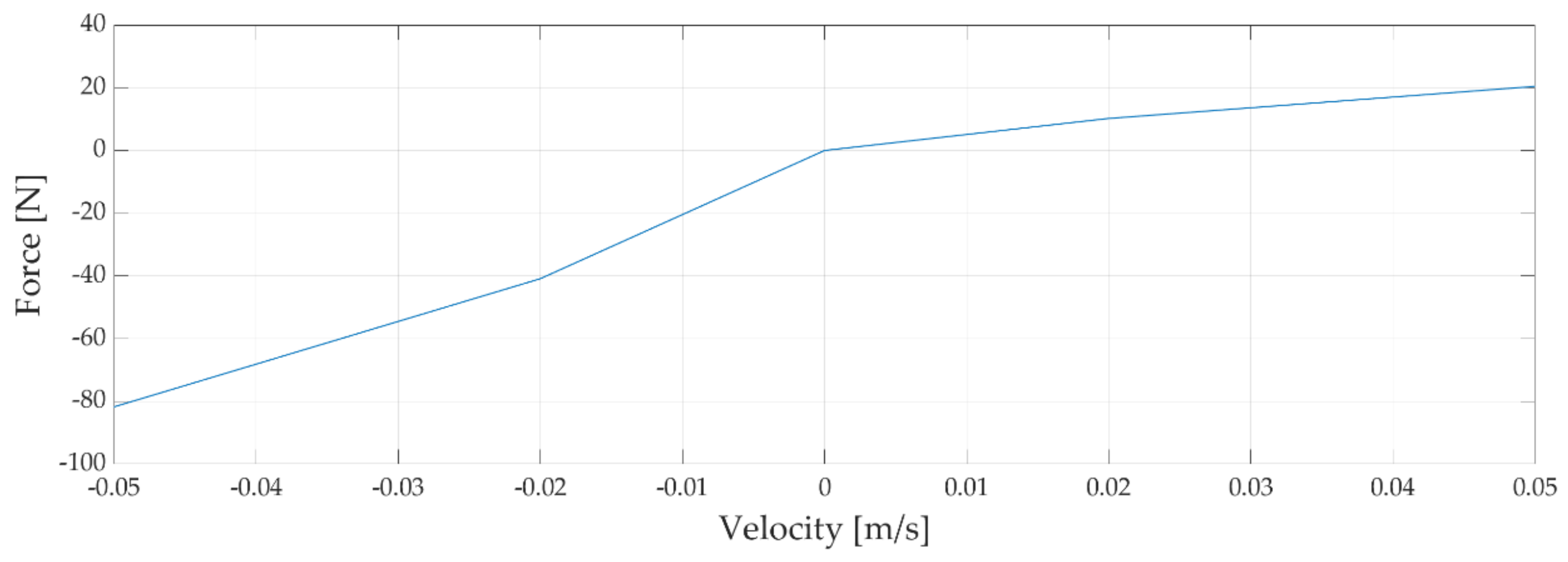
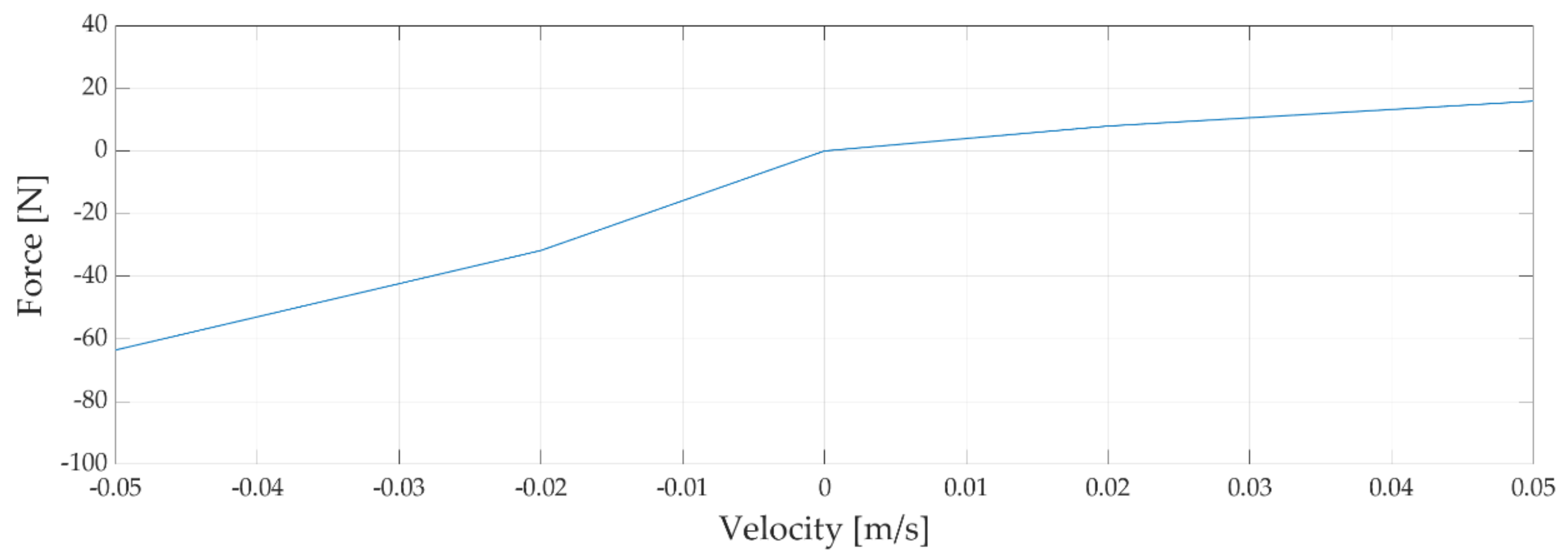
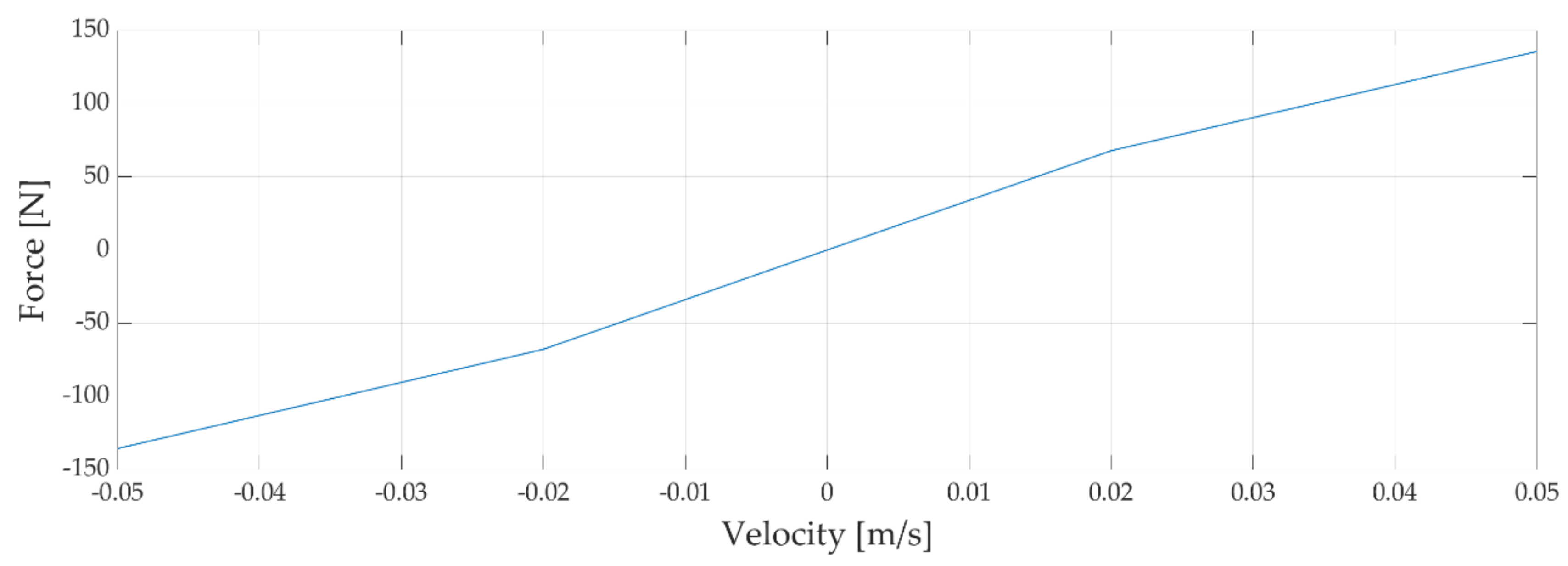
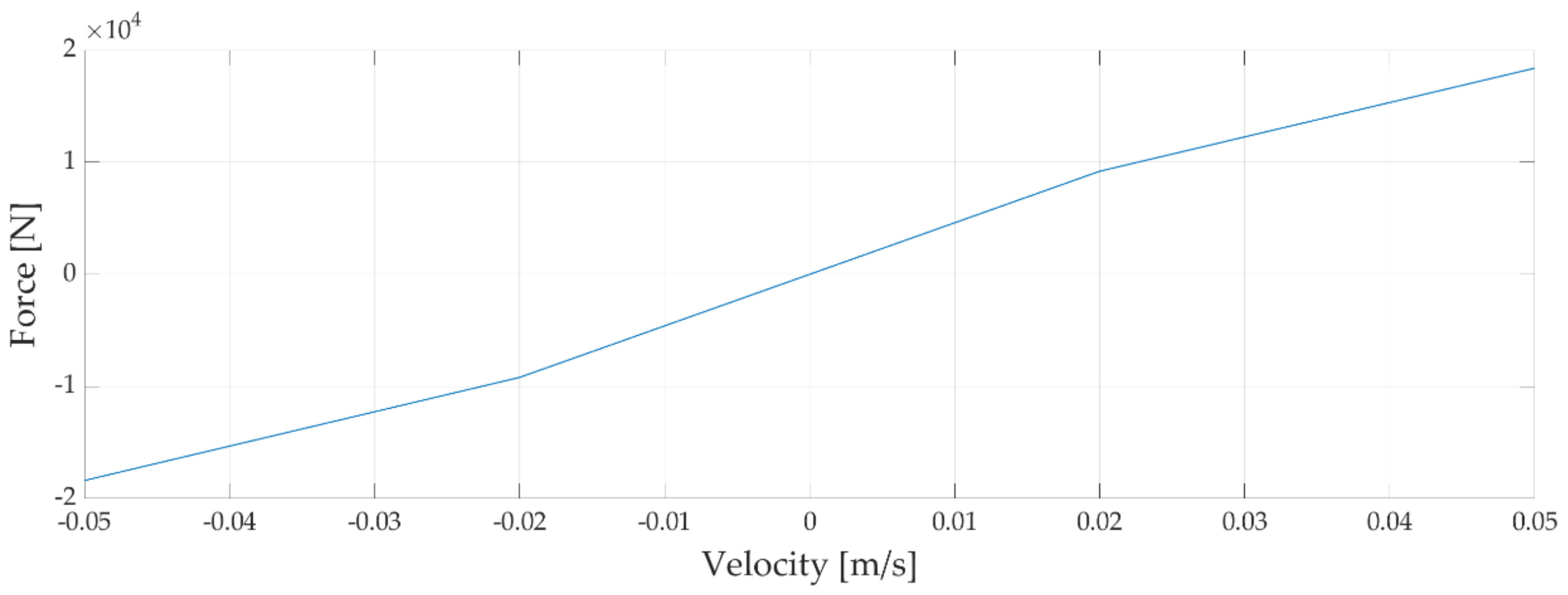
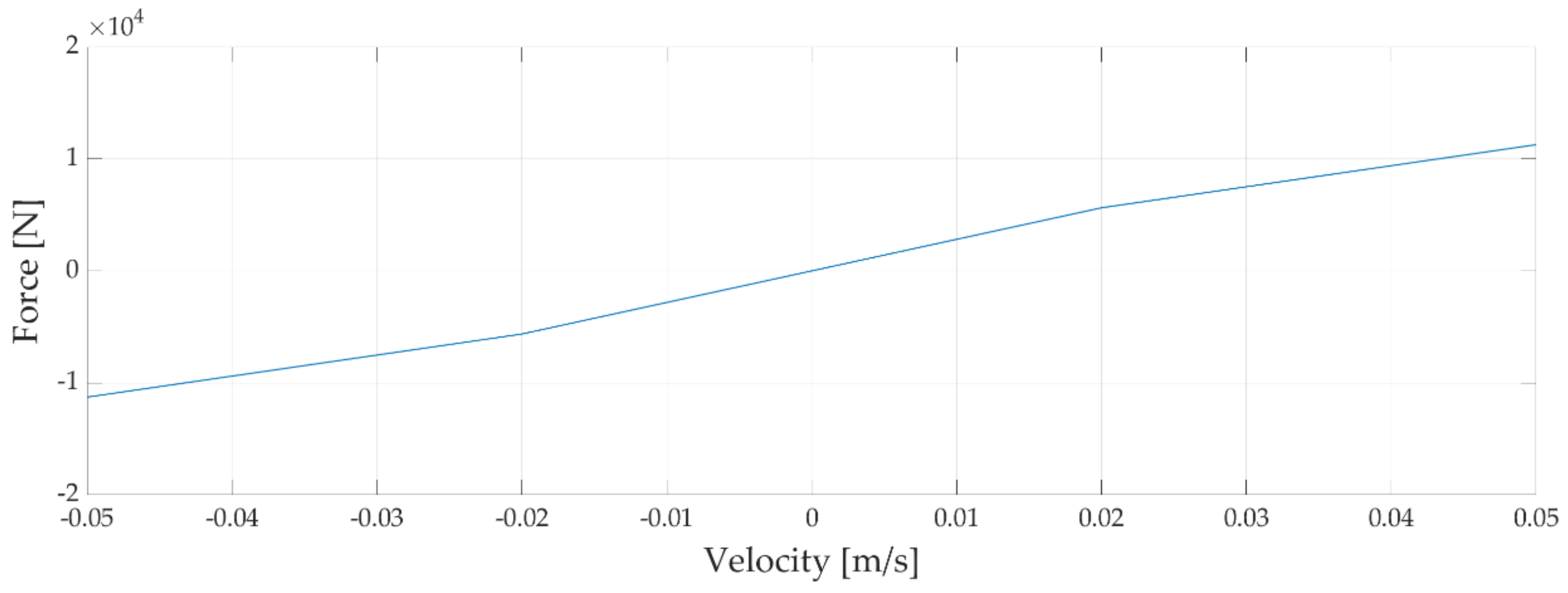
References
- Rouelle, C. Advanced Vehicle Dynamics Applied to Race Car Design; OptimumG: Centennial, CO, USA, 2018. [Google Scholar]
- Smith, M.C.; Walker, G.W. Interconnected vehicle suspension. Proc. Inst. Mech. Eng. Part D J. Automob. Eng. 2005, 219, 295–307. [Google Scholar] [CrossRef]
- Yao, Z. Design and Analysis of an Interconnected Suspension for a Small Off-Road Vehicle. Master’s Thesis, University of Windsor, Windsor, ON, Canada, 2016. [Google Scholar]
- Berman, R. Optimization of a Three Spring and Damper Suspension. Ph.D. Thesis, University of the Witwatersrand, Johannesburg, South Africa, 2016. [Google Scholar]
- Hawley, J.B. Shock Absorber and the Like for Vehicles. U.S. Patent US1647518A, 1 November 1927. [Google Scholar]
- Moulton, A.E.; Best, A. Hydragas® Suspension; SAE Technical Paper, No. 790,374; SAE International: New York, NY, USA, 1979. [Google Scholar]
- Munday, R.A.; Monk, R. Hydraulic System for A Vehicle. Australia Patent AU2003900894A0, 13 March 2003. [Google Scholar]
- Glover, A.R.; Burnham, P.A. A Damper Unit for A Vehicle Suspension System and A Vehicle Including Such A Damper Unit. UK Patent GB2474030A, 2009. [Google Scholar]
- Smith, M.; Hoult, W.; Brezas, P. McLaren Earns Its Ph. D. in Handling: McLaren Automotive and the University of Cambridge Collaborate on a No-Compromise Semi-Active Suspension for the 720S Supercar; Automotive Engineering; SAE International: New York, NY, USA, 2018; pp. 34–35. [Google Scholar]
- Collins, S. F1 2014 Explained: What is FRICS? Racecar Engineering. Available online: https://www.racecar-engineering.com/tech-explained/f1-2014-explained-what-is-frics (accessed on 5 May 2021).
- Jazar, R.N. Vehicle Dynamics: Theory and Application, 2nd ed.; Springer: Cham, Switzerland, 2017; Chapter 13. [Google Scholar]
- Giariffa, M.; Brisson, S. Tech Tip: Spring & Dampers, Episode Four, a New Understanding; OptimumG: Centennial, CO, USA, 2017. [Google Scholar]
- Rijk, S.V. Optimization of the Damper Settings of the URE05e. Master’s Thesis, Eindhoven University of Technology, Eindhoven, The Netherlands, 2010. [Google Scholar]
- Milliken, W.F.; Milliken, D.L. Race Car Vehicle Dynamics, 2nd ed.; Society of Automotive Engineers: Warrendale, PA, USA, 1995; Chapter 22. [Google Scholar]
- Dixon, J.C. The Shock Absorber Handbook, 2nd ed.; John Wiley & Sons: Hoboken, NJ, USA; Professional Engineering Publishing: Chichester, UK, 2007. [Google Scholar]
- MATLAB Version 9.8.0 (R2020a); The MathWorks Inc.: Natick, MA, USA, 2010.
- OptimumLap Version 1.4; OptimumG: Centennial, CO, USA, 2020.
- Patton, C. Development of Vehicle Dynamics Tools for Motorsports. Ph.D. Thesis, Oregon State University, Corvallis, OR, USA, 2013. [Google Scholar]
- Agostinacchio, M.; Ciampa, D.; Olita, S. The vibrations induced by surface irregularities in road pavements—A Matlab® approach. Eur. Transp. Res. Rev. 2014, 6, 267–275. [Google Scholar] [CrossRef]
- Durfee, W.; Sun, Z.; Van de Ven, J. Fluid Power System Dynamics; Center for Compact and Efficient Fluid Power: Minneapolis, MN, USA, 2009. [Google Scholar]



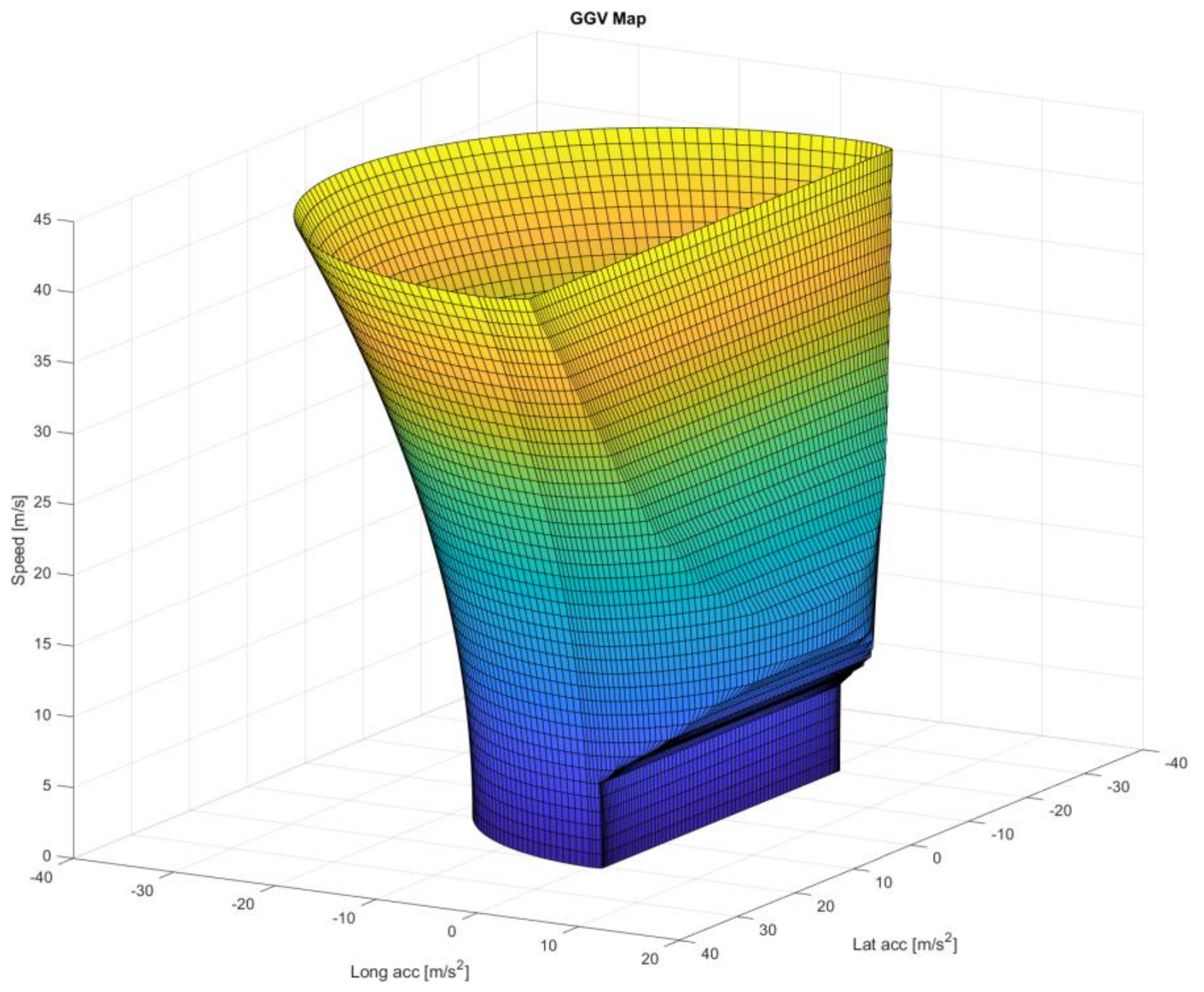
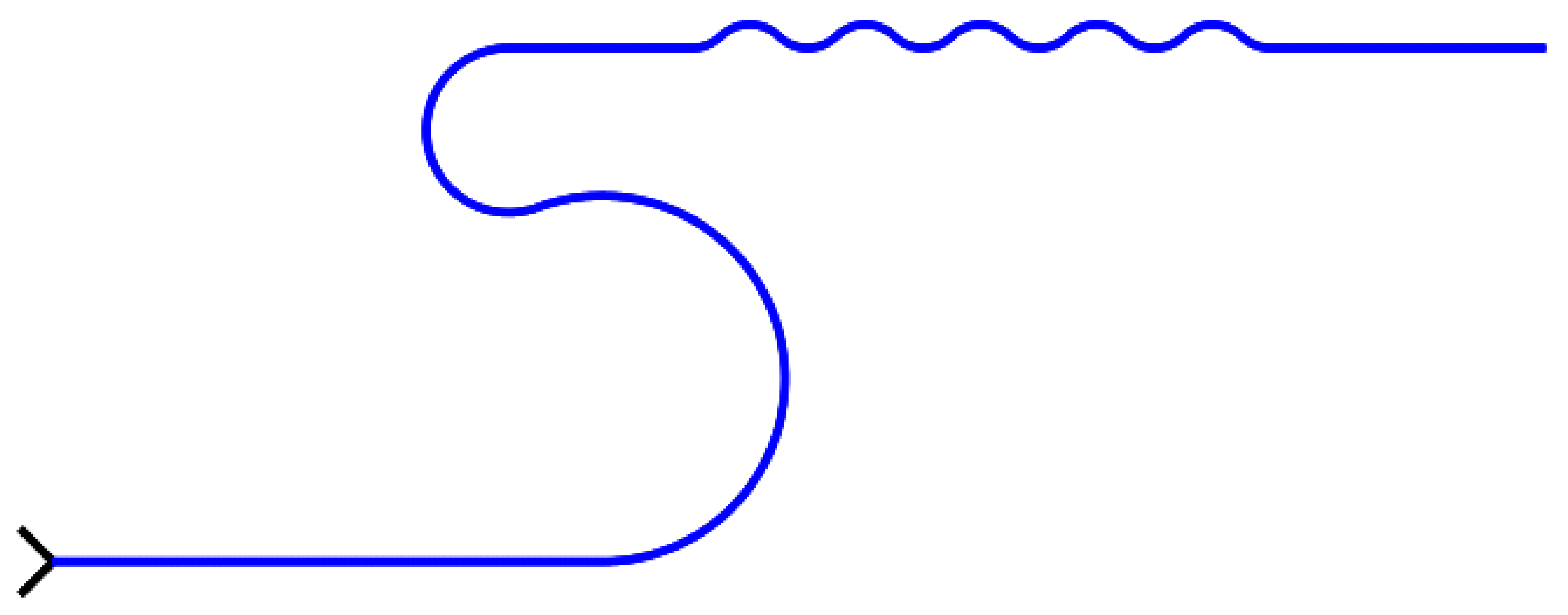

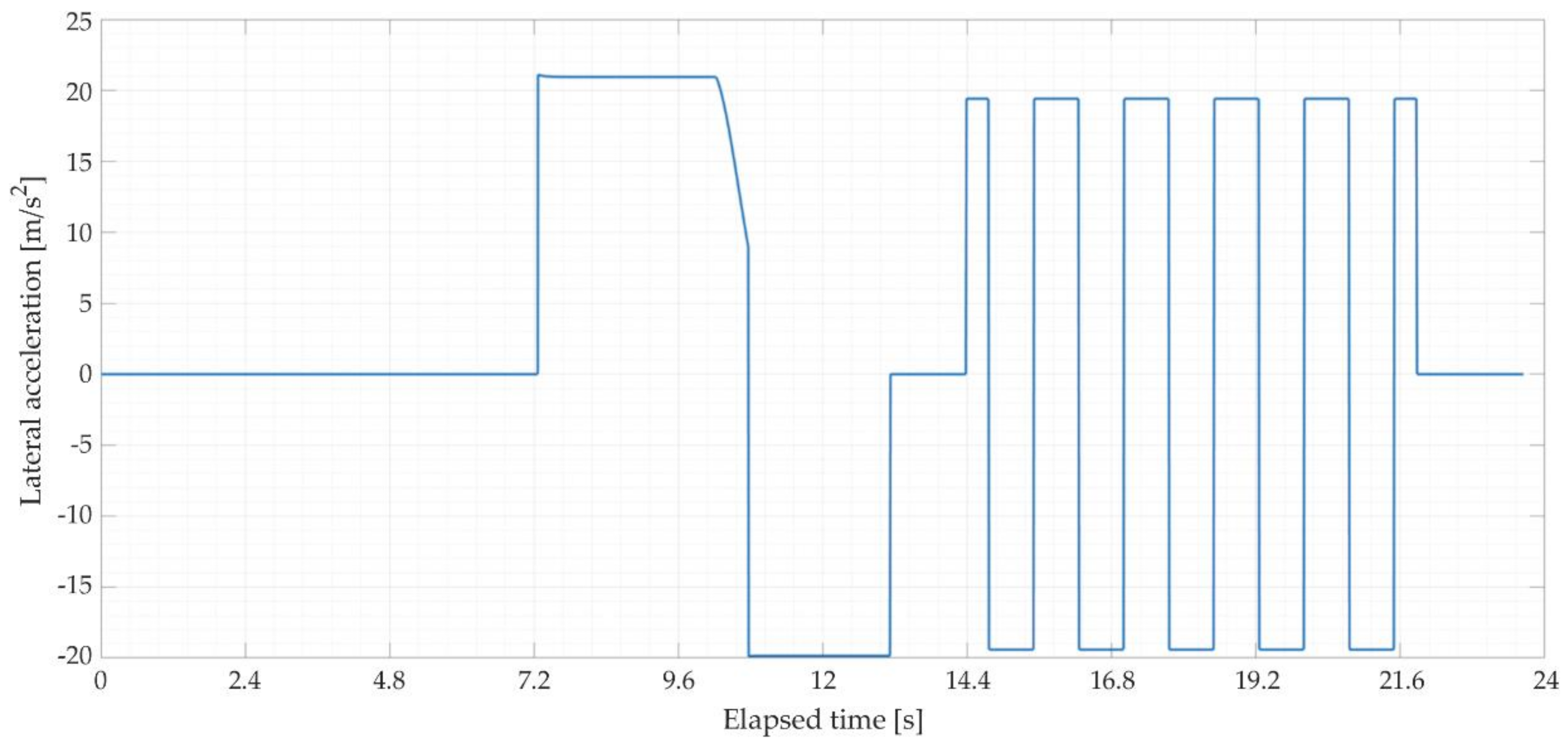
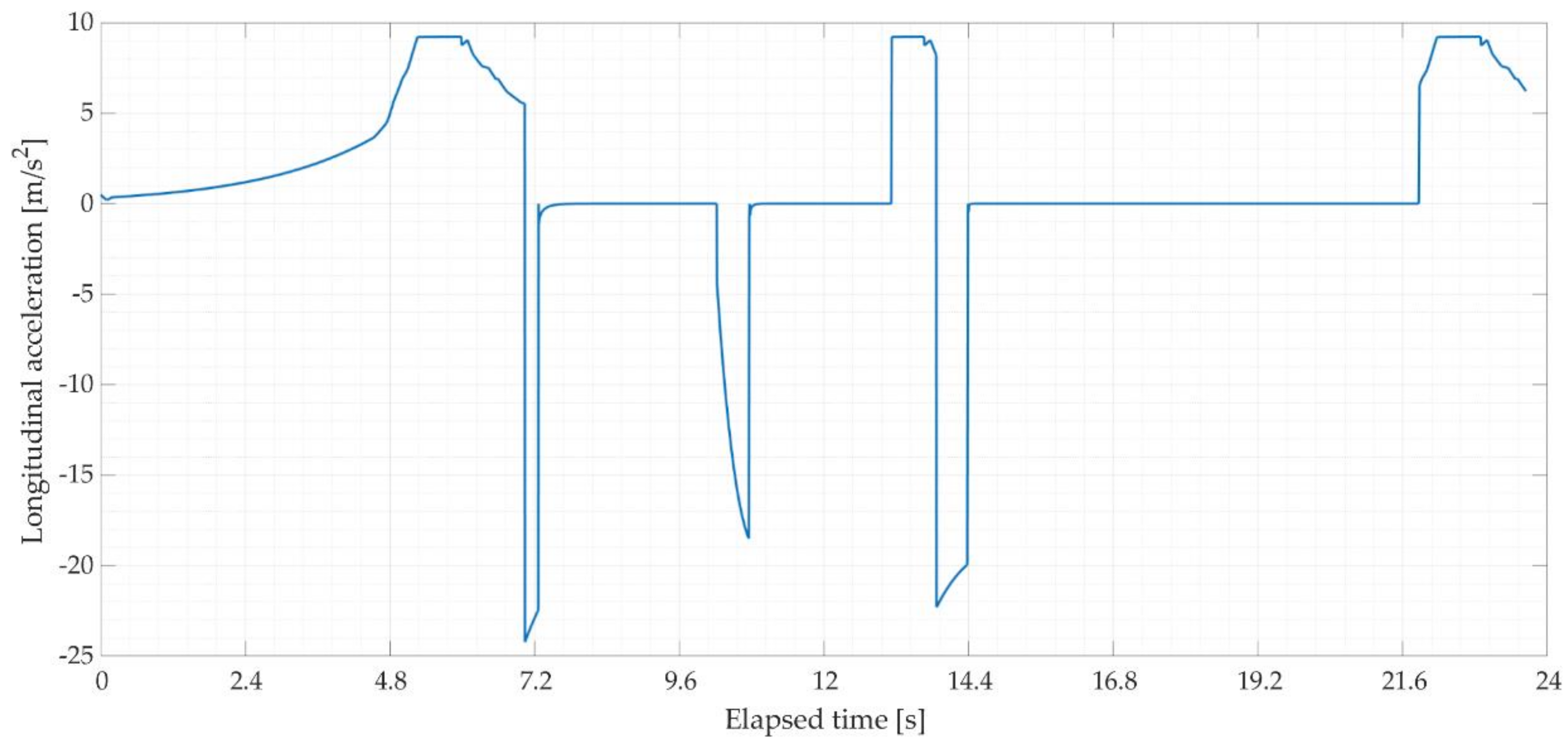



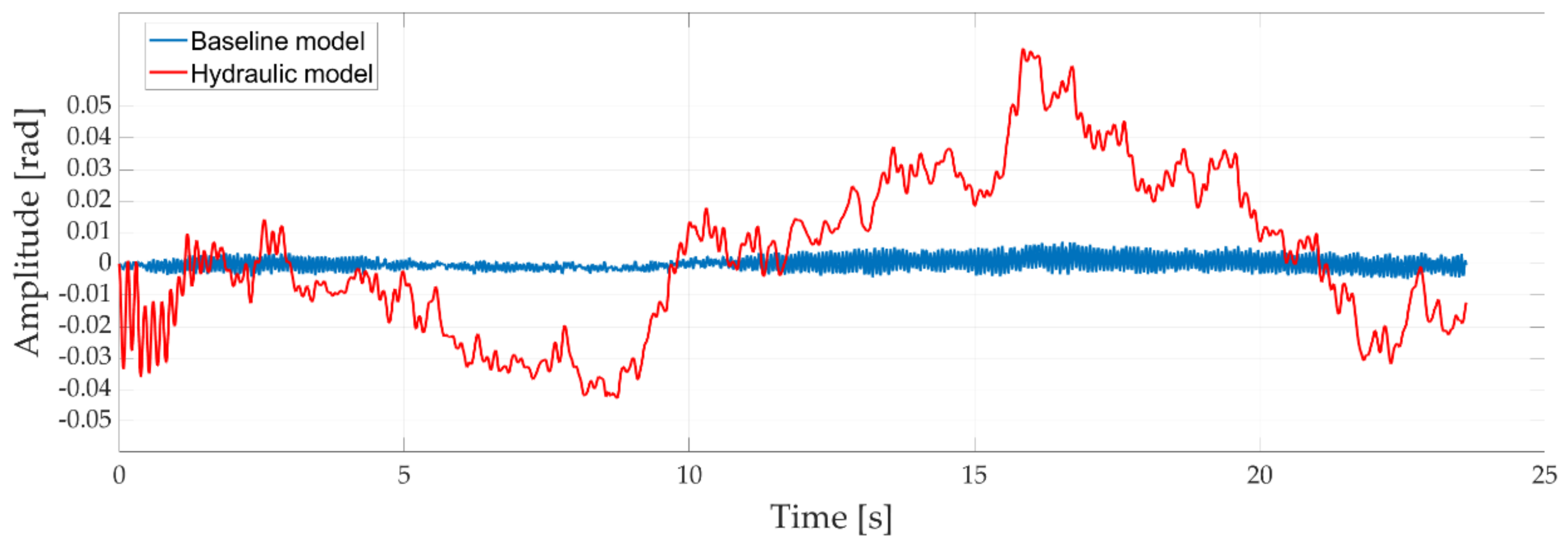
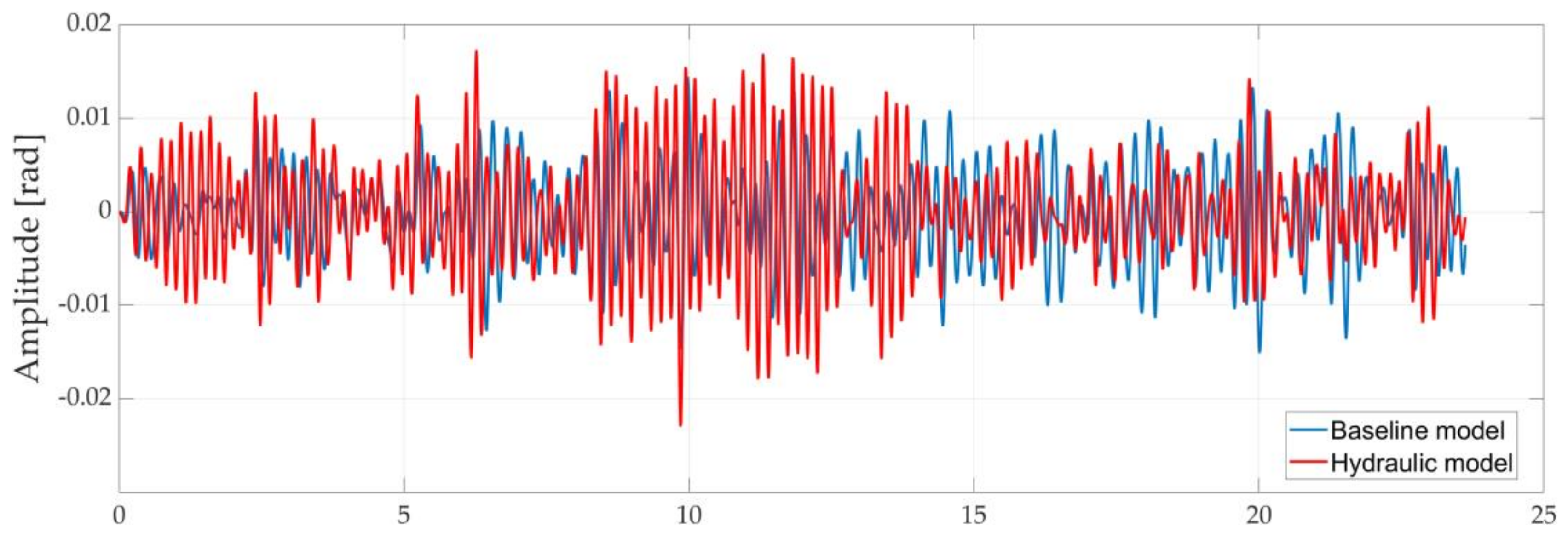
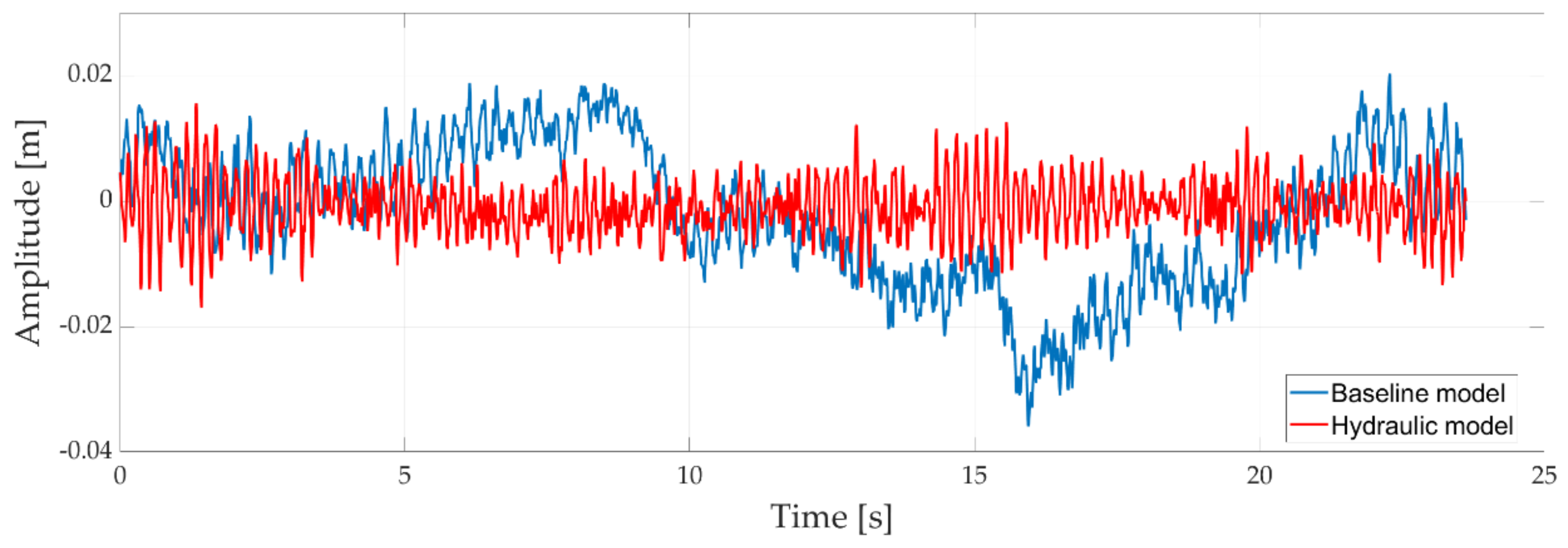

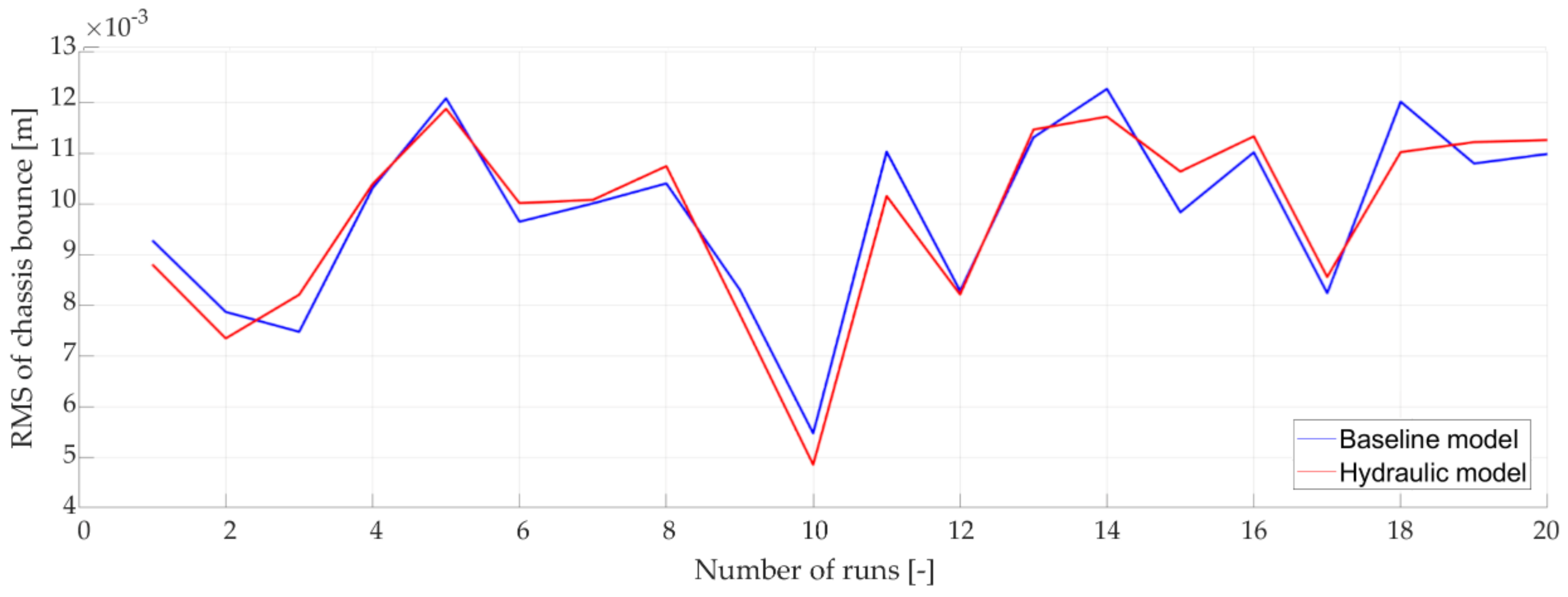

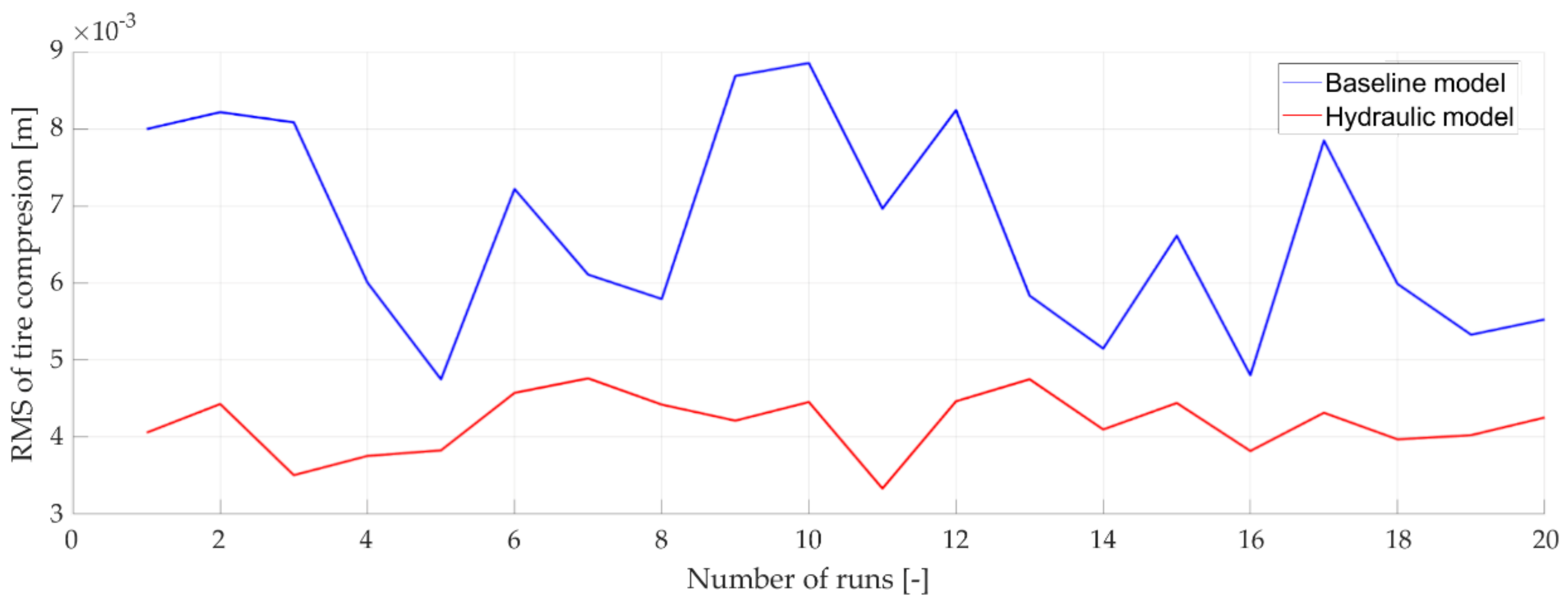


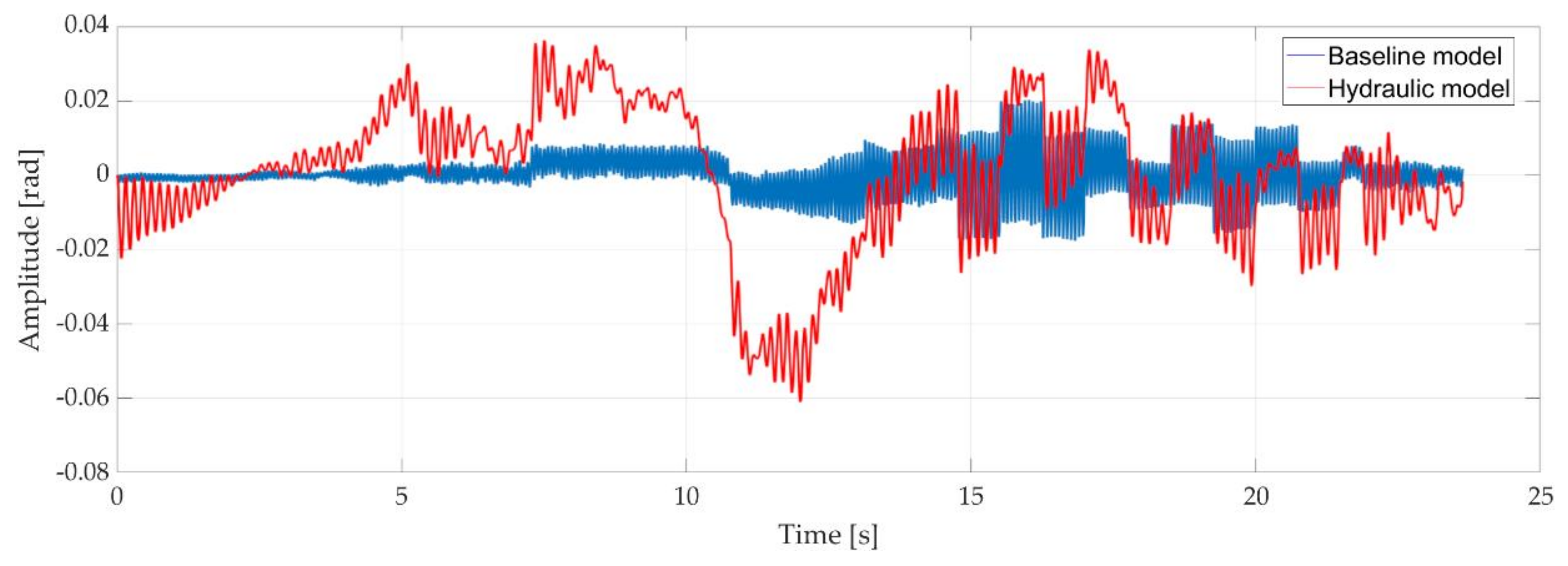


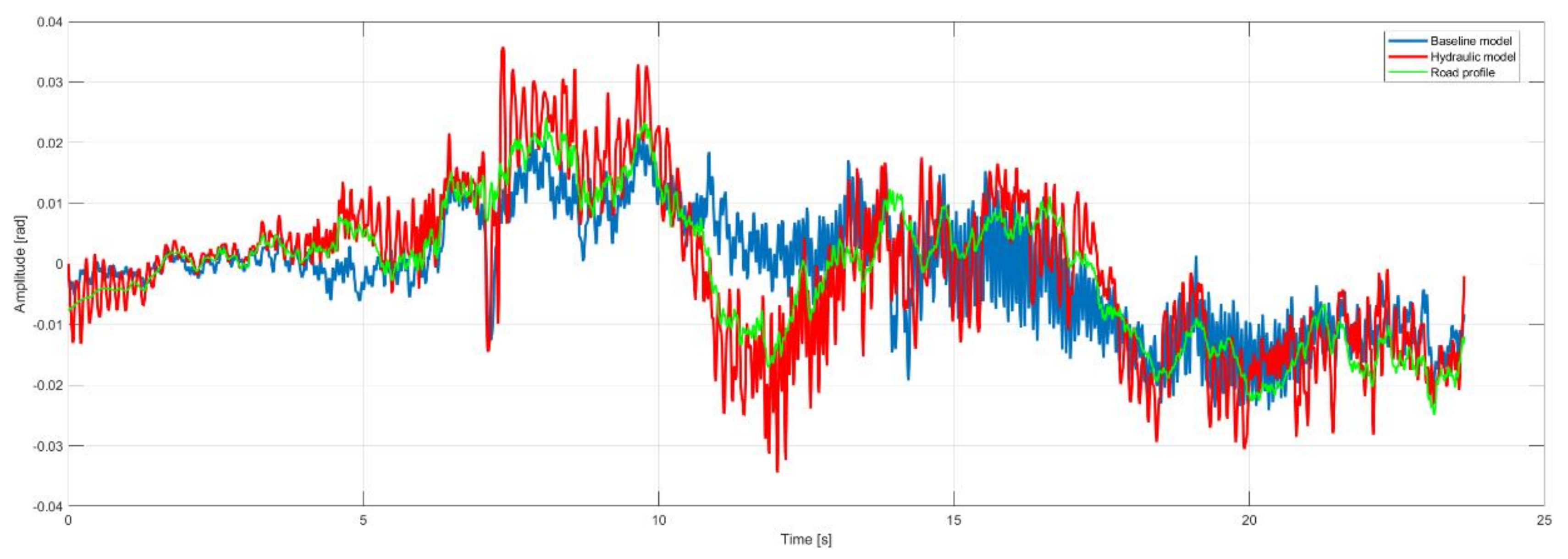
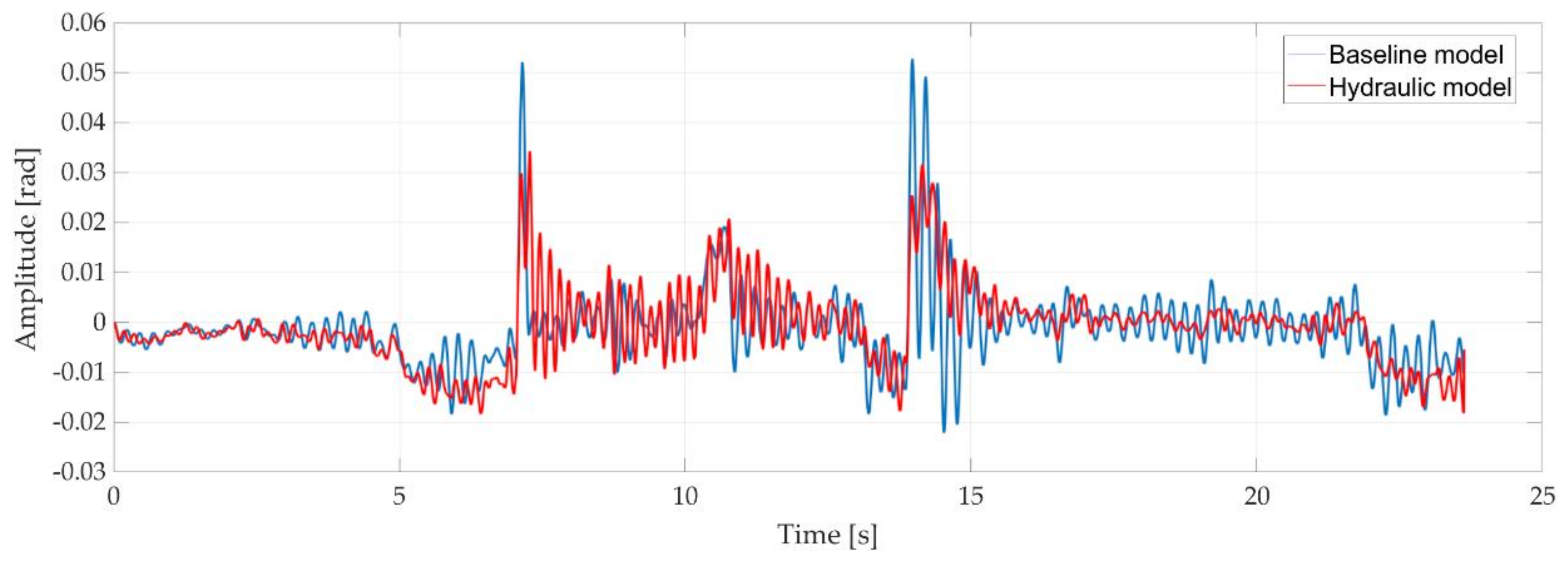
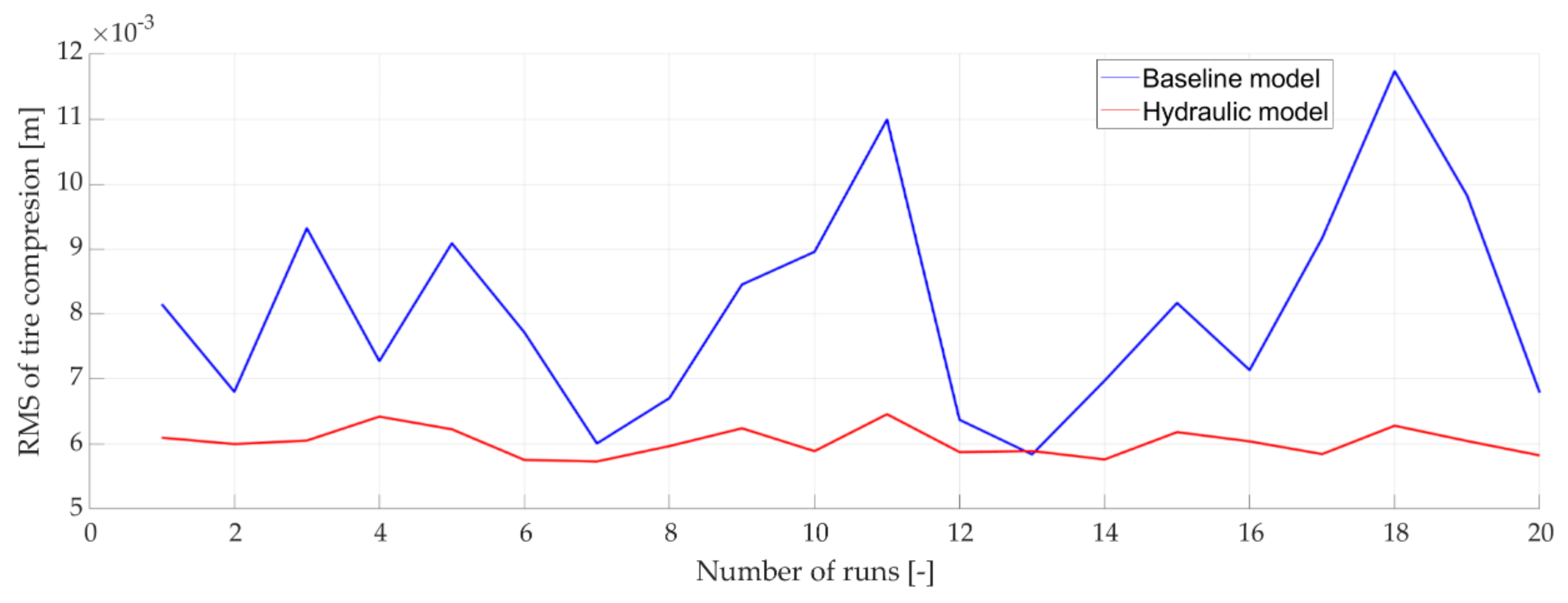


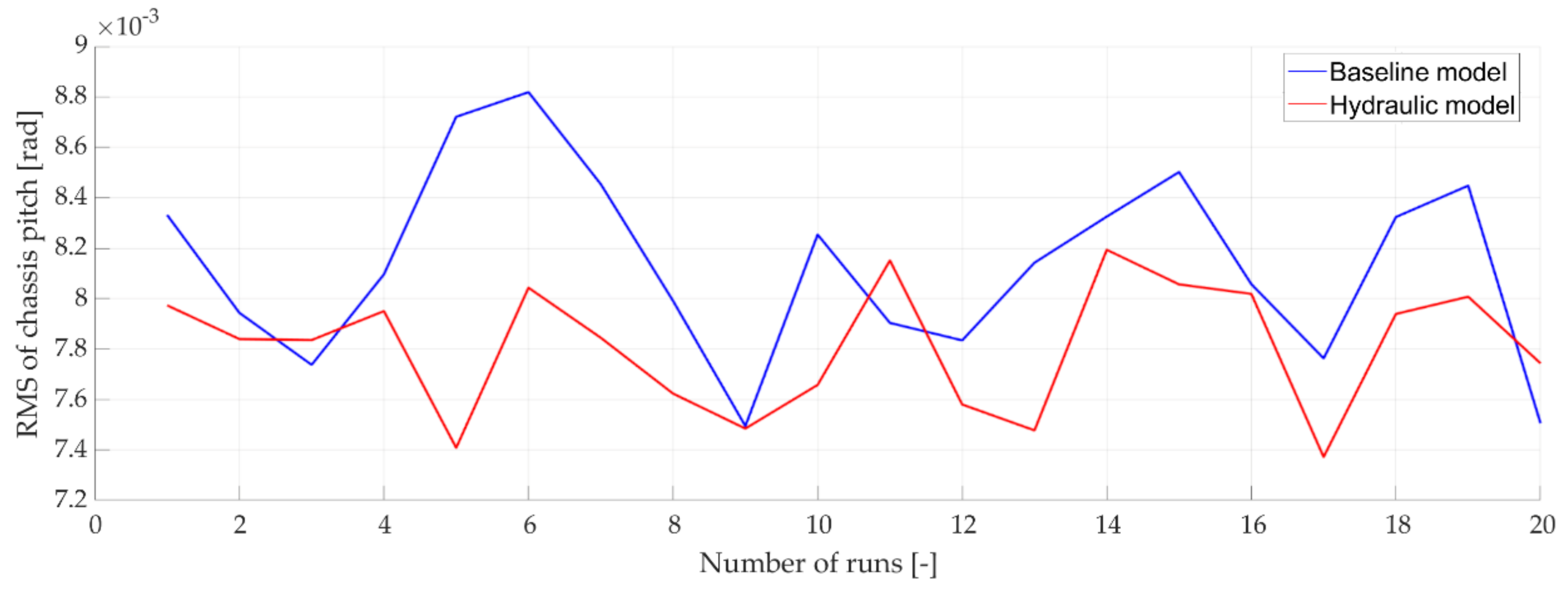
Publisher’s Note: MDPI stays neutral with regard to jurisdictional claims in published maps and institutional affiliations. |
© 2021 by the authors. Licensee MDPI, Basel, Switzerland. This article is an open access article distributed under the terms and conditions of the Creative Commons Attribution (CC BY) license (https://creativecommons.org/licenses/by/4.0/).
Share and Cite
Pridie, A.-C.; Antonya, C. The Theoretical Study of an Interconnected Suspension System for a Formula Student Car. Appl. Sci. 2021, 11, 5507. https://doi.org/10.3390/app11125507
Pridie A-C, Antonya C. The Theoretical Study of an Interconnected Suspension System for a Formula Student Car. Applied Sciences. 2021; 11(12):5507. https://doi.org/10.3390/app11125507
Chicago/Turabian StylePridie, Andrei-Cristian, and Csaba Antonya. 2021. "The Theoretical Study of an Interconnected Suspension System for a Formula Student Car" Applied Sciences 11, no. 12: 5507. https://doi.org/10.3390/app11125507
APA StylePridie, A.-C., & Antonya, C. (2021). The Theoretical Study of an Interconnected Suspension System for a Formula Student Car. Applied Sciences, 11(12), 5507. https://doi.org/10.3390/app11125507






